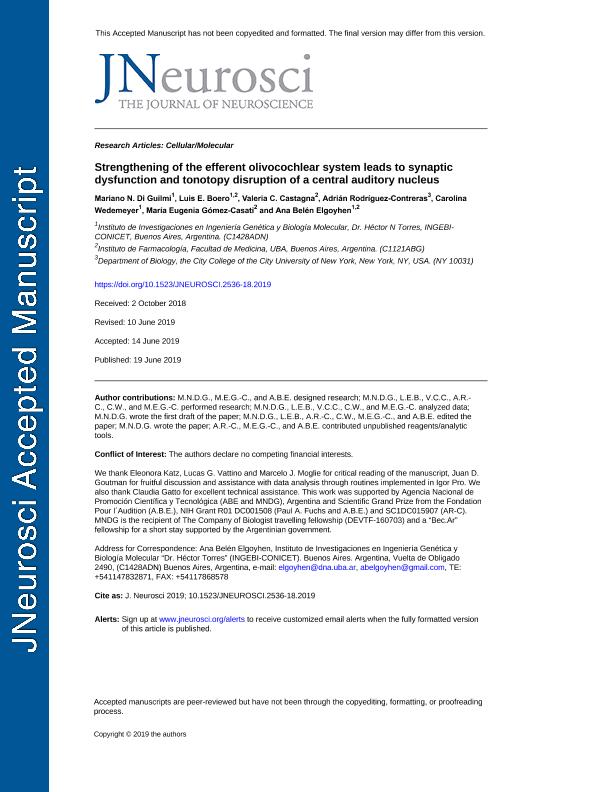Mostrar el registro sencillo del ítem
dc.contributor.author
Di Guilmi, Mariano Nicolás

dc.contributor.author
Boero, Luis Ezequiel

dc.contributor.author
Castagna, Valeria C.
dc.contributor.author
Rodríguez Contreras, Adrián
dc.contributor.author
Wedemeyer, Carolina

dc.contributor.author
Gomez Casati, Maria Eugenia

dc.contributor.author
Elgoyhen, Ana Belen

dc.date.available
2021-03-05T12:29:54Z
dc.date.issued
2019-06
dc.identifier.citation
Di Guilmi, Mariano Nicolás; Boero, Luis Ezequiel; Castagna, Valeria C.; Rodríguez Contreras, Adrián; Wedemeyer, Carolina; et al.; Strengthening of the Efferent Olivocochlear System Leads to Synaptic Dysfunction and Tonotopy Disruption of a Central Auditory Nucleus; Society for Neuroscience; Journal of Neuroscience; 39; 36; 6-2019; 7037-7048
dc.identifier.issn
0270-6474
dc.identifier.uri
http://hdl.handle.net/11336/127606
dc.description.abstract
The auditory system in many mammals is immature at birth but precisely organized in adults. Spontaneous activity in the inner ear plays a critical role in guiding this maturation process. This is shaped by an efferent pathway that descends from the brainstem and makes transient direct synaptic contacts with inner hair cells. In this work, we used an α9 cholinergic nicotinic receptor knock-in mouse model (of either sex) with enhanced medial efferent activity (Chrna9L9'T, L9'T) to further understand the role of the olivocochlear system in the correct establishment of auditory circuits. Wave III of auditory brainstem responses (which represents synchronized activity of synapses within the superior olivary complex) was smaller in L9'T mice, suggesting a central dysfunction. The mechanism underlying this functional alteration was analyzed in brain slices containing the medial nucleus of the trapezoid body (MNTB), where neurons are topographically organized along a mediolateral (ML) axis. The topographic organization of MNTB physiological properties observed in wildtype (WT) was abolished in L9'T mice. Additionally, electrophysiological recordings in slices indicated MNTB synaptic alterations. In vivo multielectrode recordings showed that the overall level of MNTB activity was reduced in the L9'T The present results indicate that the transient cochlear efferent innervation to inner hair cells during the critical period before the onset of hearing is involved in the refinement of topographic maps as well as in setting the properties of synaptic transmission at a central auditory nucleus.SIGNIFICANCE STATEMENT Cochlear inner hair cells of altricial mammals display spontaneous electrical activity before hearing onset. The pattern and firing rate of these cells are crucial for the correct maturation of the central auditory pathway. A descending efferent innervation from the CNS contacts the hair cells during this developmental window. The present work shows that genetic enhancement of efferent function disrupts the orderly topographic distribution of biophysical and synaptic properties in the auditory brainstem and causes severe synaptic dysfunction. This work adds to the notion that the transient efferent innervation to the cochlea is necessary for the correct establishment of the central auditory circuitry.
dc.format
application/pdf
dc.language.iso
eng
dc.publisher
Society for Neuroscience

dc.rights
info:eu-repo/semantics/openAccess
dc.rights.uri
https://creativecommons.org/licenses/by-nc-sa/2.5/ar/
dc.subject
CHRNA9L9′T
dc.subject
EFFERENT MOC INHIBITION
dc.subject
MNTB
dc.subject
TONOTOPY
dc.subject
Α9Α10 NACHR
dc.subject.classification
Otras Ciencias Biológicas

dc.subject.classification
Ciencias Biológicas

dc.subject.classification
CIENCIAS NATURALES Y EXACTAS

dc.title
Strengthening of the Efferent Olivocochlear System Leads to Synaptic Dysfunction and Tonotopy Disruption of a Central Auditory Nucleus
dc.type
info:eu-repo/semantics/article
dc.type
info:ar-repo/semantics/artículo
dc.type
info:eu-repo/semantics/publishedVersion
dc.date.updated
2021-01-13T16:20:57Z
dc.identifier.eissn
1529-2401
dc.journal.volume
39
dc.journal.number
36
dc.journal.pagination
7037-7048
dc.journal.pais
Estados Unidos

dc.journal.ciudad
Washington
dc.description.fil
Fil: Di Guilmi, Mariano Nicolás. Consejo Nacional de Investigaciones Científicas y Técnicas. Instituto de Investigaciones en Ingeniería Genética y Biología Molecular "Dr. Héctor N. Torres"; Argentina
dc.description.fil
Fil: Boero, Luis Ezequiel. Consejo Nacional de Investigaciones Científicas y Técnicas. Instituto de Investigaciones en Ingeniería Genética y Biología Molecular "Dr. Héctor N. Torres"; Argentina. Universidad de Buenos Aires. Facultad de Medicina. Instituto de Farmacologia; Argentina
dc.description.fil
Fil: Castagna, Valeria C.. Universidad de Buenos Aires. Facultad de Medicina. Instituto de Farmacologia; Argentina
dc.description.fil
Fil: Rodríguez Contreras, Adrián. City University Of New York. The City College Of New York.; Estados Unidos
dc.description.fil
Fil: Wedemeyer, Carolina. Consejo Nacional de Investigaciones Científicas y Técnicas. Instituto de Investigaciones en Ingeniería Genética y Biología Molecular "Dr. Héctor N. Torres"; Argentina
dc.description.fil
Fil: Gomez Casati, Maria Eugenia. Universidad de Buenos Aires. Facultad de Medicina. Instituto de Farmacologia; Argentina. Consejo Nacional de Investigaciones Científicas y Técnicas; Argentina
dc.description.fil
Fil: Elgoyhen, Ana Belen. Consejo Nacional de Investigaciones Científicas y Técnicas. Instituto de Investigaciones en Ingeniería Genética y Biología Molecular "Dr. Héctor N. Torres"; Argentina. Universidad de Buenos Aires. Facultad de Medicina. Instituto de Farmacologia; Argentina
dc.journal.title
Journal of Neuroscience

dc.relation.alternativeid
info:eu-repo/semantics/altIdentifier/url/https://www.jneurosci.org/content/39/36/7037
dc.relation.alternativeid
info:eu-repo/semantics/altIdentifier/doi/http://dx.doi.org/10.1523/JNEUROSCI.2536-18.2019
Archivos asociados
